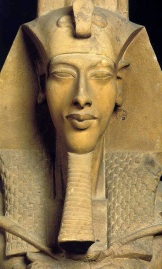 In the 14th century BC, Pharaoh Amenhotep IV initiated a religious revolution in Egypt. He introduced worship of the sun disk Aten to eclipse the worship of all the other gods of Egypt. He changed his own name to Akhenaten, and he built a new capital city, Akhetaten, in which the pure worship of Aten could take place. The temples were roofless—open to the rays of the sun disk.
In the 14th century BC, Pharaoh Amenhotep IV initiated a religious revolution in Egypt. He introduced worship of the sun disk Aten to eclipse the worship of all the other gods of Egypt. He changed his own name to Akhenaten, and he built a new capital city, Akhetaten, in which the pure worship of Aten could take place. The temples were roofless—open to the rays of the sun disk.
When Akhenaten died, his revolution died with him. His successor, Tutankhamun (yes, that pharoah!) oversaw the reversion back to Egypt’s traditional religion. The capital city, Akhetaten was abandoned to the sands of time. Its ruins are now part of the site known as Tell el-Amarna.
Some fantastic imaging by Archéovision has recreated some of Akhenaten’s old capital city in digital form. If you can, watch the clip below in fullscreen mode and in full HD (click on the HD symbol and choose the resolution). It’s a brief but impressive recreation.
You can read a little more about this HERE.


